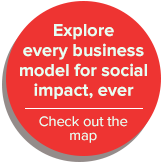While over the years, minds have become more and more open to the concept of a business model in which over 50% of the work is given away for free, there are still a handful of very common critiques. These critiques are actually not unique to the verynice business model, but instead are critiques that surround the pro-bono industry at large. Thanks to a handful of very influential thought leaders in the marketing and design industries who have devoted much of their career towards explaining how “charity” shouldn’t be “charitable,” and how value is lost when something is given away for free, a little army of nay-sayers has been brewing. This section is an attempt to address frequently asked questions that are framed as critiques toward giving half of your work away for free.
K1: Wait, if we all stop charging for the work, won’t it negatively affect our economy?
Don’t worry! If we all stop charging for our work, we won’t negatively affect the economy or destroy an industry. The industry is too powerful for that to happen. In the United States there are close to 27 million corporations and only 1 million non-profit organizations. At verynice, we operate under the mentality that if we need to make money and we need to grow revenue, we can do that amongst the majority of institutions that would actually profit off of the work that we are doing. This mindset serves as primary points of inspiration for the concept of splitting focus equally between non-profit/pro-bono work as well as for-profit/paid work. It should also be known that, because of the unique staffing model and volunteer engagement component to this business model there is literally no overhead when it comes to engaging in a pro-bono relationship besides your own time and whatever else you are willing to offer. We always ask that the non-profit fund its own hard costs or the hard costs involved in the work we may be doing which has included printing, website hosting, and shipping charges.
K2: If my model relies so much on freelancers as opposed to employees, doesn’t that lack a contribution to unemployment rates?
verynice has a small office that is home to, as of this writing, about 10 individuals. verynice is the primary source of income for about 50% of those people—meaning many of them are part time and are making money elsewhere to subsidize their life. We are not necessarily a company with a heavy focus on job creation as our mission and vision are more highly invested elsewhere.
We have entered a world in which the 9-5 lifestyle is slowly dying out. We hope to be pioneers of an alternative perspective on the workplace— the idea that we can actually hold multiple lives and not necessarily have our entire work week surrounded by one single business. By employing over 250 freelancers and contractors worldwide, we are supporting the new “freelancer economy” by providing irregular income that upon cross pollination with other revenue sources for each contractor, is in fact a means of thriving—buying a home, leasing a new car, paying off student loans, etc.
K3: Wouldn’t spending more money, instead of less, on design and marketing help a non-profit organization actually do better?
If a non-profit organization were to spend a ton of money on design and marketing expenses instead of less, they should be able to make more impact, right? Wrong. Well, OK, I won’t say wrong, but it depends on your definition of “impact.”
Yes, if a non-profit organization spent more money on design and marketing, it would be more impactful in raising awareness around their mission and vision, and would become a household name more quickly, therefore attracting donations. When a non-profit spends close to half of its operating budget on “outreach”, “awareness”, or “membership”, it is indeed creating more impact around what it does, BUT it is not necessarily creating impact on its cause. Having 2 million Facebook fans will not necessarily convert into providing 2 million vaccinations. Giving away millions of stickers and T-shirts will allow the majority of the population to know who you are, but it will not necessarily inspire the majority of the population to donate to your cause.
When an organization spends money, it is my sincere belief that every last dime of that should be going towards the investment of resources to help an organization come closer to their mission and vision. Of course the wealth of knowledge that a service provider can offer to a non-profit is vast and can in many cases get an organization closer to obtaining its vision, but it is not necessarily the most valuable way to spend those dollars.
K4: Why would you do this when you could be making twice as much money?
A common belief is that if you leverage a model in which you give half of your work away for free you will, in fact, only make half the amount that you normally would. This was something that I had actually assumed as well upon launching the model, but then one key component changed my perspective entirely: collaboration.
A key component of this model is collaboration and a welcoming attitude towards remote “outsourcing” and networking to get the work done. As I started to welcome this attitude as one of my primary business strategies, I began to realize that I was able to actually take on twice the amount of work that I would have, due to the intensity of my bandwidth. 100% of the collaborators in my network came to me with interest solely in volunteering their services and working as unpaid freelancers to help in verynice’s mission to alleviate expenses for non-profit organizations.
If verynice did not have a pro-bono business model like we do, the strange reality is that we actually would not make any more money than we currently are. Instead, we would make exactly the same in regards to revenue.
